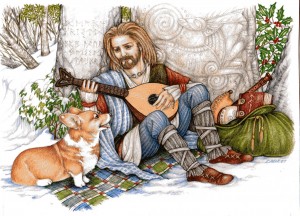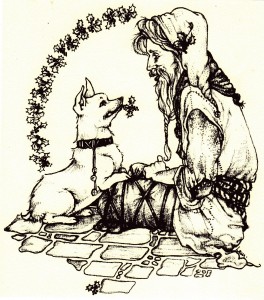So… many, many, many years ago, when i was about 8 or 9 (after my family moved to Florida) we finally got our first dog. My brother and i had our hearts set on a Manchester Toy Terrier (or at least i did) having seen one owned by a friend of my grandmother, but of course that breed was a bit obscure so not readily available at the place my parents took us. I don’t recall the details of what spurred the decision to get a dog that particular afternoon, or why my dad chose that specific place (in my memory it was just some pens by the side of the road, but i could be way off). The whys and wherefores are really rather immaterial now, what is important is – we found a Welsh Corgi.
I can’t say enough wonderful things about the breed now, but at the time we knew nothing about them. All i know is – there was this animated, adorable, sweet puppy in a litle cage and she just won our hearts. All thoughts of the “must have” terrier vanished in the presence of her winning smile and personality (and yes – corgis DO smile). In retrospect – now that i’m an adult and have several years of “mom” experience and pets under my belt – i suspect it was my mother who actually chose her, but the decision was unanimous and Tiefy became our family dog and started an obsession with the breed that has lasted a lifetime.
And all of this is a rather long preamble to explain why Welsh Corgis (specifically Pembroke Welsh Corgis) have been a long, and cherished inspiration. Tiefy was my first introduction to the breed, later – when our daughter was about three years old – Tasha became my second. We had Tasha (named for the wonderful children’s book illustrator who featured them, Tasha Tudor) for 14 years, and the year she died i dedicated this Christmas card to her. Since she was mentioned briefly in 2009’s “Auld Lang Syne” card i have been eager to share her own special illustration story.
2007
Fourteen years ago, Tasha appeared at Christmas time and proceeded to weave her own unique magic through our lives. This Christmas there was never any doubt or question that my annual 2007 holiday greeting would celebrate our little corgi’s wonderful life and memory. Of course, me being me, i couldn’t just leave it at that and simply draw a picture of her. Instead, in typical Laurie Christmas Card tradition, there is a convoluted story behind the illustration’s ultimate incarnation. For one thing, i have long wanted to use the Welsh bard, Taliesin (c. 534 – c. 599), in a card (you know my obsession with knights and troubadours). Considered the greatest of the Welsh poets, he is believed to have been a bard to at least three British kings of the era and his name is associated with “The Book of Taliesin“, a collection of poems that was written down in the Middle Ages and is one of the “Four Ancient Books of Wales“. According to Celtic mythology however, Taliesin was also a wizard and shaman, and the first person to acquire the skill of prophesy through the strange and supernatural circumstances of his birth and multiple incarnations. Legend further says he attained the status of Chief Bard of Britain in King Arthur’s court.
What better companion for a Welsh dog of equally fanciful and enchanted origins. In legend, the faeries and elves of Wales used corgis to pull their carriages, work their wee cattle, and serve as steeds for their faerie warriors. To this day, in fact, corgis continue to carry the mark of the faerie saddle across their shoulders. In modern times, it is theorized that Pembroke Welsh Corgis are descended from the Swedish Valhund, possibly introduced to Wales by the Vikings, so there is a wealth of magic and adventure in Tasha’s heritage as well.
Independent and sweet tempered, with beautiful bright eyes and a happy smile, i picture Tasha now in the land of her ancestors ~ inspiring sages, delighting troubadours, compelling wizards, and encouraging kings in the company of King Arthur’s Bard.
~ Twenty seven years ago (give or take) my fourth Christmas card depicted a Welsh corgi (Tiefy) with a “young” Medieval Santa. That original design was the basic inspiration for the 2007 card – but with more flourishes.
The New Flourishes:
STANDING STONES ~ Dating back to Neolithic times, their precise date and function remains uncertain, but their connection to the Celts is legendary and not a little magical. [NOTE: See “Auld Lang Syne” illus. 2009]
THE ALPHABETS: “Futhark” ~ The message on the stone to the left is written in the Viking Runic alphabet called Futhark. Most inscriptions in stone were in normal runes while another version of the alphabet was used for everyday messages on wood or bone. I combined both alphabet variations for this message and while i realize it might be hard to decipher the sentiment without the full code i bet you can still figure it out.
“Ogham” ~ Running along the edges of the center and right stone are a series of notches and grooves depicting the earliest Celtic alphabet called Ogham. Dating from the 4th and 5th centuries it was believed to be the magic writing of the Druids. In this case there isn’t any real message, i just wanted to show an example of the script.
TORC ~ Decorative neck ring indicating high rank and status, closely associated with Celtic deities.
IN THE SACK ~ The “Book of Taliesin”, a bodhran, recorder, and skin of mulled wine (the traditional tools of the bard).
THE ANIMALS ~ “Dog” – well that’s obvious. But also associated with healing. “Salmon” – a source of knowledge. One of Talieson’s incarnations was a salmon, represented here by the tail fin-shaped head of the lute. “White Stag” – represents the eternal cycle of nature manifested in the seasonal shedding and regrowth of antlers. Oh yeah, and in this case also Santa’s reindeer.
THE PLANTS ~ The Holly and Ivy are probably pretty obvious given the carol, but they were also sacred to the Celts for magical healing qualities, as was the Mistletoe.
TALIESIN ~ Was loosely based on the statue of the Celtic general, Vercingetorix (by Aime’ Millet 1819-91) because, in all honesty, i thought he looked cute .

